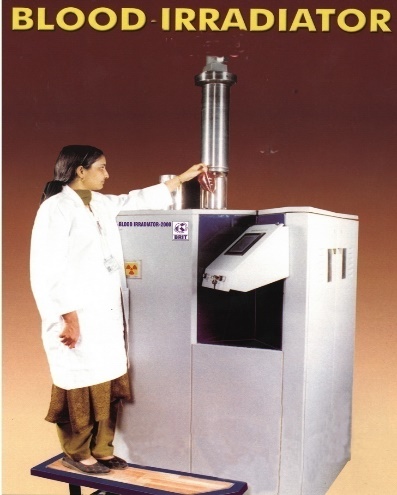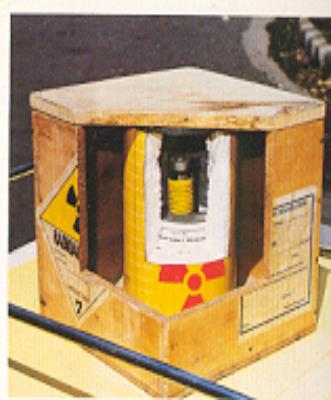Transport of Radioactive material
|
e-LORA guideline for transport-Radiation Facilities e-LORA guideline for transport- Department of Atomic Energy(DAE) |
With the increase in the application of radiation sources in various fields such as medicine, industry, agriculture, research and training, the transport of radioactive material has increased manifold which involves the movement of radioactive material from the place of manufacture to the place of use, from one place of use to another place of use and from the place of use to the agency responsible for the safe disposal. In India, more than a lakh of packages are being transported annually with activities varying from the order of few kilo Becquerel to Peta Becquerel. Atomic Energy Regulatory Board (AERB) is the national regulatory authority for enforcement of the regulations for safe handling of radiation sources and transport of radioactive materials.The transport of radioactive material in India is governed by the AERB code on Safe Transport of Radioactive Material (AERB/NRF-TS/SC-1 (Rev.1), 2016 which is based on IAEA regulations for ‘Safe Transport of Radioactive Material’ SSR-6, 2012 Edition.
AERB has also published a regulatory guide titled ‘Security of Radioactive Material during Transport’, (AERB/NRF-TS/SG-10), 2008. The guide establishes security levels commensurate with the potential radiological consequences that could result from malicious use of radioactive material. The objective of this document is to provide guidance, to an authorised user of radioactive material, consignor, carrier and other concerned persons, in implementing , maintaining security in order to protect radioactive material while in transport against theft, sabotage or other malicious acts that could result in significant radiological consequences.
The AERB code on Safe Transport of Radioactive Material (AERB/NRF-TS/SC-1 (Rev.1) 2016) prescribes the classification, design and test requirements for radioactive material, classification, design and test requirements for packagings, packages and corresponding activity limits, requirements with respect to controls for transport and approval and administrative requirements
Package is the complete product of the packing operation, consisting of the Packaging and its contents prepared for transport
The basic requirement for the transport of radioactive material is that the package containing the material shall be designed and prepared in such a way that during the whole process of transport, the radioactive material remains contained to prevent contamination and remains shielded to avoid unacceptable radiation exposure to cargo handlers and public. As the activity and nature of radioactive material to be transported varies over a wide range i.e. from few kBq (few µCi) to few PBq (thousands of Ci), a graded approach is used in selection of the packaging.
Radioactive material can be in special form i.e. non-dispersible or sealed encapsulated source or other than special form. Therefore, the regulations provide for different type of packages to be used depending upon the nature, physical form and activity of the radioactive material. The Types of packages used for the transport of radioactive materials are Excepted package, Industrial package (Type IP-1, Type IP-2, Type IP-3), Type A package, Type B(U), Type B(M) and Type C package.
Different Types of Packages used
Excepted packages: Please refer to section 5.5 of the AERB safety code on Safe Transport of Radioactive Material (AERB/NRF-TS/SC-1 (Rev.1) 2016), for details on classification, limits and requirements on excepted packages.
Type A packages are used for the transport of moderate activity of radioactive material such as nucleonic gauge sources, some brachytherapy sources used in hospitals, nuclear medicine sources used for diagnostic and therapeutic purposes (Permitted activity A1 in special form and A2 in other than special form). They are designed to withstand normal conditions of transport.
The regulations provide for limits on the activity which can be transported in the above package in terms of A1 and A2. A1 is the maximum activity of radioactive material which can be transported in Type A package when the material is in special form and A2 is the maximum activity of radioactive material which can be transported in Type A package when the material is not in special form.
A1 and A2 values of some common radioisotopes are given in the table "A1 and A2 values of some common radioisotopes"
Type B(U)/B(M) Packages are used for the transport of large activity of radioactive material as per the approval of the competent authority i.e. AERB such as tele-therapy sources, gamma irradiators sources, industrial radiography sources.
Type C Packages are used for transport of very high radioactivity by air. They are designed to withstand severe accident conditions of transport.
Safety During Transport
The prime responsibility for ensuring compliance with the regulations lies with the consignor. The consignor needs to ensure that the appropriate packaging is selected for the transport of radioactive material and the package is prepared, marked and labelled as per the regulations. Guidelines for the preparation of the package are given in "Procedures for preparation of packages".
Once the package is prepared as per the prescribed procedures, it can be transported by any mode of transport i.e. by road, rail, sea or air.
- Instructions to the carrier
- Declaration by the consignor
- Transport Emergency Card (TREMCARD)
- Instructions on emergency measures
For information on above three bullets, see "Procedures for preparation of packages".
Major transport related information
- Application form for Registration of TYPE-A Package
- Application form for Design approval of TYPE-B Package
- Categories of Packages, Over packs and Freight Containers
- Port Clearance form ( JNPT)
- Port Clearance form ( Others)
- Check list for packaging and transport
- Excepted packages
- Industrial package requirements for LSA material and SCO
- Consignments requiring Exclusive use
- Approved TYPE-A package details
- Approved TYPE-B package details
- Planning and preparing for emergency response to Transport accidents involving RAM
- Transport User's Guide for Preparation of Transport Package
Relevant regulatory documents
AERB/NRF-TS/SC-1 (Rev.1)Safe Transport of Radioactive Material 2016
AERB/NRF-TS/SG-10, Security of Radioactive Material During Transport, 2008












